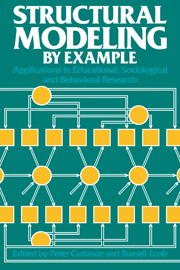
-
Select format
-
- Publisher:
- Cambridge University Press
- Publication date:
- 12 January 2010
- 29 April 1988
- ISBN:
- 9780511601118
- 9780521261951
- 9780521115247
- Dimensions:
- (228 x 152 mm)
- Weight & Pages:
- 0.642kg, 330 Pages
- Dimensions:
- (229 x 152 mm)
- Weight & Pages:
- 0.49kg, 332 Pages
- Subjects:
- Sociology: General Interest, Experimental Psychology, Psychology, Sociology
You may already have access via personal or institutional login- Subjects:
- Sociology: General Interest, Experimental Psychology, Psychology, Sociology
Book description
Structural Modeling by Example offers a comprehensive overview of the application of structural equation models in the social and behavioural sciences and in educational research. It is devoted in roughly equal proportions to substantive issues and to methodological ones. The substantive section comprises case studies of the use of these models in a number of disciplines. The authors emphasize the reasons for modeling by these methods, the processes involved in defining the model, and the interpretation of the results. Each substantive chapter includes an exemplary data set and formal model construction of give readers practice in setting up the models and interpreting the results. The methodological section comprises investigations of the behaviour of structural equation modeling methods under a number of conditions. The aim is to clarify the situations in which these methods can usefully be applied and the interpretations that can be made.
Reviews
"...the editors of Structural Modeling by Example have discriminatingly selected papers that discuss important and often neglected issues of CS analysis and document examples of applications. It will serve both students and researchers well." Journal of the American Statistical Association
Contents
Metrics
Altmetric attention score
Full text views
Full text views help Loading metrics...
Loading metrics...
* Views captured on Cambridge Core between #date#. This data will be updated every 24 hours.
Usage data cannot currently be displayed.
Accessibility standard: Unknown
Why this information is here
This section outlines the accessibility features of this content - including support for screen readers, full keyboard navigation and high-contrast display options. This may not be relevant for you.
Accessibility Information
Accessibility compliance for the PDF of this book is currently unknown and may be updated in the future.


